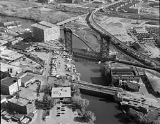
Canal Street railroad bridge
Encyclopedia
The Canal Street railroad bridge (or Pennsylvania Railroad bridge) is a vertical lift bridge across the south branch of the Chicago River
in Chicago
, Illinois. When it was constructed in 1914 its 1500 ton main span was the heaviest of any vertical lift bridge in the United States. It is the only vertical lift bridge across the Chicago River, and it was designated a Chicago Landmark on 12 December 2007.
to replace a two track swing bridge
at the same location. The necessity to allow both continued use of the swing bridge and unimpeded river traffic during building work complicated construction of the bridge. The chosen solution was to construct the bridge in the raised position above the old bridge, then demolish the old bridge once construction was completed. The bridge was designed by Waddell & Harrington, and fabricated and erected by the Pennsylvania Steel Company.
Construction of the south tower began on September 4, 1913. When the two 185 feet (56.4 m) towers were completed, falsework
for the main span was constructed in a fan shape that allowed the main span to be constructed in the raised position 130 feet (39.6 m) above the river.
 The bridge carries two railroad tracks across the Chicago River at an angle of about 40˚ to the center line of the river. Upon completion, the main span could be raised 111 feet (33.8 m) in about 45 seconds. By 1916, each day the bridge was crossed by about 300 trains, and was raised for river traffic about 75 times.
The bridge carries two railroad tracks across the Chicago River at an angle of about 40˚ to the center line of the river. Upon completion, the main span could be raised 111 feet (33.8 m) in about 45 seconds. By 1916, each day the bridge was crossed by about 300 trains, and was raised for river traffic about 75 times.
Chicago River
The Chicago River is a system of rivers and canals with a combined length of that runs through the city of the same name, including its center . Though not especially long, the river is notable for being the reason why Chicago became an important location, as the link between the Great Lakes and...
in Chicago
Chicago
Chicago is the largest city in the US state of Illinois. With nearly 2.7 million residents, it is the most populous city in the Midwestern United States and the third most populous in the US, after New York City and Los Angeles...
, Illinois. When it was constructed in 1914 its 1500 ton main span was the heaviest of any vertical lift bridge in the United States. It is the only vertical lift bridge across the Chicago River, and it was designated a Chicago Landmark on 12 December 2007.
Construction
The present bridge was constructed for the Pennsylvania RailroadPennsylvania Railroad
The Pennsylvania Railroad was an American Class I railroad, founded in 1846. Commonly referred to as the "Pennsy", the PRR was headquartered in Philadelphia, Pennsylvania....
to replace a two track swing bridge
Swing bridge
A swing bridge is a movable bridge that has as its primary structural support a vertical locating pin and support ring, usually at or near to its centre of gravity, about which the turning span can then pivot horizontally as shown in the animated illustration to the right...
at the same location. The necessity to allow both continued use of the swing bridge and unimpeded river traffic during building work complicated construction of the bridge. The chosen solution was to construct the bridge in the raised position above the old bridge, then demolish the old bridge once construction was completed. The bridge was designed by Waddell & Harrington, and fabricated and erected by the Pennsylvania Steel Company.
Construction of the south tower began on September 4, 1913. When the two 185 feet (56.4 m) towers were completed, falsework
Falsework
Falsework consists of temporary structures used in construction to support spanning or arched structures in order to hold the component in place until its construction is sufficiently advanced to support itself...
for the main span was constructed in a fan shape that allowed the main span to be constructed in the raised position 130 feet (39.6 m) above the river.
Operation


